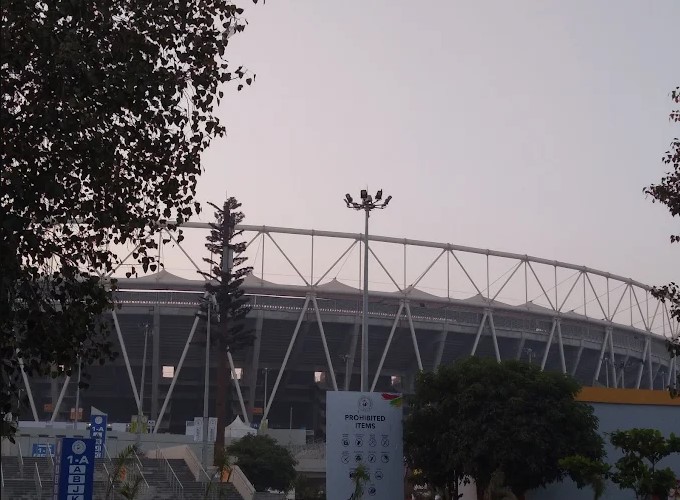Sardar Patel Stadium, also known as Narendra Modi Stadium, located in Ahmedabad, Gujarat, is one of the most iconic cricket stadiums in the world. Renowned for its massive seating capacity and state-of-the-art facilities, this stadium has redefined the standards of cricket venues globally. Among various parameters that define the playing conditions and the character of the ground, the boundary length plays a crucial role in influencing the gameplay, scoring patterns, and overall spectator experience.
Table of Contents
This article delves deep into the boundary length specifics of the Sardar Patel Stadium, its impact on cricket matches, comparisons with other major cricket grounds, and the significance of boundary measurements in cricket.
Overview of Sardar Patel Stadium
The stadium was renovated extensively and reopened in 2020 with a seating capacity of over 132,000, making it the largest cricket stadium in the world. The playing area itself has been designed to international standards, with precise boundary measurements to ensure fair play.
| Feature | Details |
|---|---|
| Location | Ahmedabad, Gujarat, India |
| Seating Capacity | 132,000+ |
| Renovation Completion | 2020 |
| Ground Dimensions | Oval shape, varying boundaries |
| Owner | Gujarat Cricket Association |
Importance of Boundary Length in Cricket
The boundary length in cricket is the distance from the center of the pitch to the edge of the playing field, where the rope or fence marks the boundary. It directly impacts how batsmen play shots, how bowlers strategize, and how field placements are arranged.
- Shorter boundaries tend to favor batsmen, making it easier to score fours and sixes.
- Longer boundaries encourage bowlers to be more aggressive and batsmen to be more tactical.
Boundary length also affects the type of shots played, influencing whether a batsman opts for a ground shot or an aerial shot.
Boundary Length at Sardar Patel Stadium
At Sardar Patel Stadium, the boundary length varies around the ground due to its oval shape, which is typical for most cricket grounds. The stadium’s design adheres to ICC regulations for international cricket grounds, which specify minimum and maximum boundary lengths to maintain fairness.
Boundary Length Measurements
| Boundary Position | Approximate Distance (meters) | Approximate Distance (yards) |
|---|---|---|
| Straight Down the Ground (Both Ends) | 65 meters | 71 yards |
| Mid-Wicket | 68 meters | 74 yards |
| Square Leg | 70 meters | 77 yards |
| Deep Point | 67 meters | 73 yards |
| Deep Cover | 69 meters | 75 yards |
| Long On | 65 meters | 71 yards |
| Long Off | 66 meters | 72 yards |
These measurements are approximate and can vary slightly depending on ground setup and playing conditions.
Comparison with Other Major Cricket Stadiums
| Stadium | Location | Approximate Boundary Length (meters) | Seating Capacity |
|---|---|---|---|
| Sardar Patel Stadium | Ahmedabad, India | 65 – 70 | 132,000+ |
| Melbourne Cricket Ground (MCG) | Melbourne, Australia | 65 – 75 | 100,000+ |
| Lord’s Cricket Ground | London, England | 65 – 75 | 30,000+ |
| Eden Gardens | Kolkata, India | 60 – 70 | 66,000+ |
| Newlands | Cape Town, South Africa | 65 – 70 | 25,000+ |
The boundary lengths at Sardar Patel Stadium are comparable to other international venues, making it a balanced ground for both batsmen and bowlers.
Impact of Boundary Length on Matches at Sardar Patel Stadium
Several cricket matches at the Sardar Patel Stadium since its reopening have demonstrated the impact of boundary length on the game:
- High scoring games: The moderate boundary lengths have enabled batsmen to clear the rope with relative ease, leading to some high-scoring innings.
- Strategic bowling: Bowlers have to be precise and vary their lengths to prevent boundaries, especially since shorter boundaries can be exploited by big hitters.
- Field placements: Captains set boundary riders carefully, balancing between saving runs and cutting off sixes.
The boundary length at the Sardar Patel Stadium is a vital aspect of the ground that shapes the dynamics of cricket played here. With distances ranging roughly from 65 to 70 meters, it strikes a balance between batsmen-friendly and bowler-friendly conditions. Its design not only meets ICC standards but also enhances the excitement and competitiveness of the game. As the stadium continues to host international fixtures, understanding its boundary dimensions will help players, coaches, and fans appreciate the subtle nuances of the game at this world-class venue.


